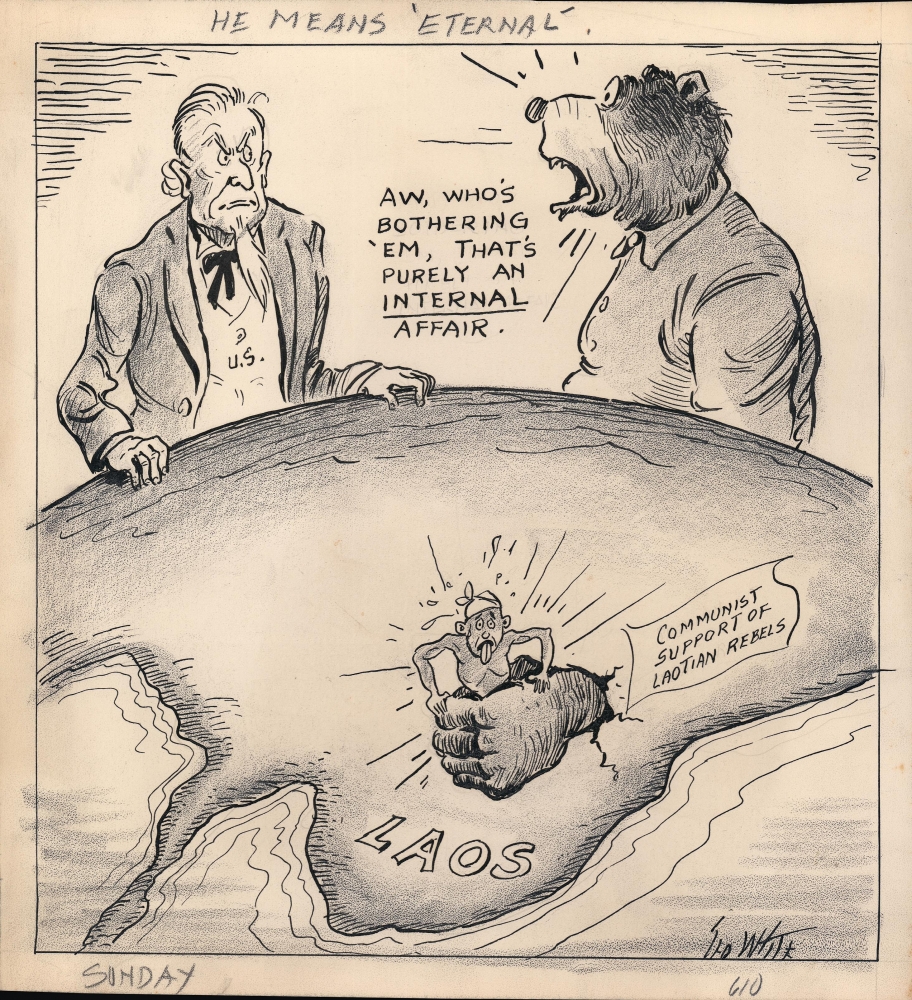1953 White Cartoon Original Art, Communist Influence in Laos
Laos-white-1953
Title
1953 (undated) 11 x 10 in (27.94 x 25.4 cm)
Description
A Closer Look
The cartoon depicts Uncle Sam conversing with a bear representing the Soviet Union. The Soviets declare that the situation in Laos is a purely internal affair, a common refrain at the time, fitting with the approach of the Comintern in the early Cold War. The title of the cartoon suggests 'eternal affair' would be a more accurate phrase, as civil conflicts between Communists and anti-Communists engulfed many territories undergoing decolonization, especially in Asia.Historical Context
As elsewhere in Southeast Asia, anti-colonial resistance in Laos predated the World War II (1939 - 1945) but was greatly strengthened by the conflict. Japan progressively occupied French Indochina in 1941, outwardly leaving much of the administrative system unchanged but quietly supporting and promoting friendly officials. In Laos, they found a capable collaborator in the reform-minded Prince Phetsarath (also Romanized as Phetxarāt). In March 1945, as Japan's wartime empire was in grave danger, a coup was launched in Indochina and leaders were installed who renounced any connection with France. When Japan surrendered shortly thereafter, the result was a chaotic and charged situation.Phetsarath tried to establish an independent kingdom at Luang Prabang, while King Sisavang was deposed for his willingness to work with France. Meanwhile, Lao nationalists who resisted the Japanese during the war cast their lot with Phetsarath. France succeeded in restoring Sisavang to the throne and granted Laos more autonomy to head off anti-colonial sentiment.
As in Vietnam, the nationalist resistance movement took on a decidedly left-wing orientation and began to receive stronger support from the Soviet Union and, from 1949, the People's Republic of China. The Pathet Lao emerged as the main force resisting the government, working in conjunction with the Viet Minh (and later North Vietnam). Simultaneously, foreign support for the government increasingly came from the United States instead of France.
As Pathet Lao activity increased, the Central Intelligence Agency responded with a range of activities meant to counter Communist influence, including the enlistment of an entire airline to ferry troops and equipment, constituting the largest CIA paramilitary operation before the Soviet-Afghan War. In later years, the U.S. Air Force undertook bombing campaigns against the portions of the Ho Chi Minh Trail that entered Laotian territory.
Despite occasional lulls in the fighting and a change of leadership in the Lao government, the civil war dragged on for years, driven by indigenous factors but also largely as an ancillary conflict to the Vietnam War (Second Indochina War). Eventually, in 1975, the Pathet Lao were able to take over the Lao government and have ruled the Lao People's Democratic Republic ever since.
Publication History and Census
This is the original manuscript draft of George White's cartoon for the Tampa Morning Tribune. As unrest and civil war in Laos was strung out over many years, an exact date is difficult to determine, but most likely it dates from 1953 or 1954, when the Pathet Lao was recognized internationally as a formidable political and military force.Cartographer
George White (1901 - March 7, 1964) was born in Grand Rapids, Michigan and relocated to Tampa with this family in 1915. White studied art under Tampa artist Walter Collins and began work as a commercial artist at the Tampa Morning Tribune in 1928 and by 1934 was a regular cartoonist at the Tribune. Rather unconventionally, the paper featured his cartoons on the front page. His work displays the evolving course of America's domestic and geopolitics from the interwar period, through the Second World War, and into the Cold War More by this mapmaker...

